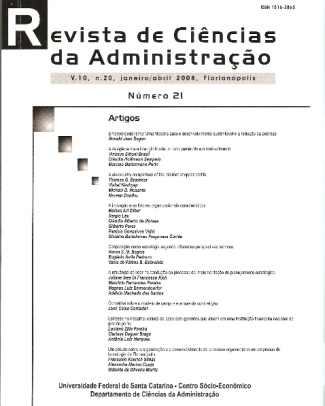Stress at work: a case study involving managers of a top nationwide financial organization
DOI:
https://doi.org/10.5007/2175-8069.2008v10n21p175Abstract
This paper presents the main results of a research project that aimed at identifying the main stress factors and diagnosing the occupational stress levels experienced by 191 managers in a large nationwide financial organization working at the organization branch located in the city of Belo Horizonte/MG. The research was conducted under descriptive and explicative research models MTEG (Zille, 2005) and lead to results that pointed out unstable work relations, over dimensioned goals, high levels of worker involvement demanded, work force below actual necessities and poor work inter-relationships as the main stress provokers in managers. Results have shown that 150 out of 168 managers (89,10%) were diagnosed as carrying some level of stress, distributed in the following groups: 59 (35,21%) had low to moderated stress levels;69 (40,97%) had high stress levels and 22 (12,92%) had very high stress levels.Downloads
Published
How to Cite
Issue
Section
License
The author must ensure:
- that there is complete consensus among all co-authors to approve the final version of the paper and its submission for publication.
- that their work is original, and if the work and/or words of others have been used, these have been duly acknowledged.
Plagiarism in all its forms constitutes unethical publishing behavior and is unacceptable. RCA reserves the right to use software or any other methods of plagiarism detection.
All submissions received for evaluation in the RCA journal are screened for plagiarism and self-plagiarism. Plagiarism identified in manuscripts during the evaluation process will result in the submission being archived. In the event of plagiarism being identified in a manuscript published in the journal, the Editor-in-Chief will conduct a preliminary investigation and, if necessary, retract it.
Authors grant RCA exclusive rights of first publication, with the work simultaneously licensed under the Creative Commons (CC BY) 4.0 International License.

Authors are authorized to enter into separate, additional contractual arrangements for the non-exclusive distribution of the version of the work published in this journal (e.g., publishing in an institutional repository, on a personal website, publishing a translation, or as a chapter in a book), with an acknowledgement of its authorship and initial publication in this journal.
This license grants any user the right to:
Share – copy, download, print, or redistribute the material in any medium or format.
Adapt – remix, transform, and build upon the material for any purpose, even commercially.
According to the following terms:
Attribution – You must give appropriate credit (cite and reference), provide a link to the license, and indicate if changes were made. You may do so in any reasonable manner, but not in any way that suggests the licensor endorses you or your use.
No additional restrictions – You may not apply legal terms or technological measures that legally restrict others from doing anything the license permits.


